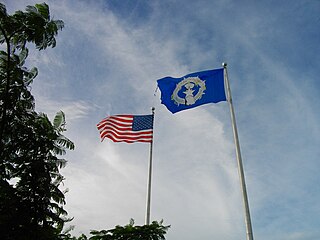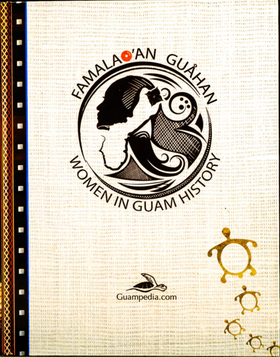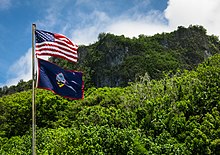
Hagåtña is the capital village of the United States territory of Guam. From the 18th through mid-20th century, it was Guam's population center, but today it is the second smallest of the island's 19 villages in both area and population. However, it remains one of the island's major commercial districts in addition to being the seat of government.

Chamorro is an Austronesian language spoken by about 58,000 people, numbering about 25,800 on Guam and about 32,200 in the Northern Mariana Islands and elsewhere. It is the native and spoken language of the Chamorro people, the indigenous people of the Mariana Islands. Chamorro has three distinct dialects: Guamanian, Rotanese, and that in the other Northern Mariana Islands (NMI).

University of Guam (U.O.G.) is a public land-grant university in Mangilao, Guam. It is accredited by the Western Association of Schools and Colleges and offers thirty-four degree programs at the undergraduate level and eleven at the master's level. Of the university's 3,387 students, 94% are of Asian-Pacific Islander ethnicity and nearly 72% are full-time. A full-time faculty of about 180 work at the university.

The Chamorro people are the Indigenous people of the Mariana Islands, politically divided between the United States territory of Guam and the encompassing Commonwealth of the Northern Mariana Islands in Micronesia, a commonwealth of the US. Today, significant Chamorro populations also exist in several U.S. states, including Hawaii, California, Washington, Texas, Tennessee, Oregon, and Nevada, all of which together are designated as Pacific Islander Americans according to the U.S. Census. According to the 2000 Census, about 64,590 people of Chamorro ancestry live in Guam and another 19,000 live in the Northern Marianas.
The music of Guam encompasses a broad range of traditional and contemporary music. Modern music from Guam includes elements of American, Spanish, Filipino and Polynesian music. The Spanish and Mexicans contributed a type of song called serenatas to the culture of Guam. Some traditional Catholic songs in the Spanish language, including "Mil Albricias", "Pastores a Belen", "Santa Maria de la Merced" or "En Lecho de Pajas" and some traditional love songs including "A mi morena", "Ay que triste desventura", "Cancion de Antonio Acosta" or "Te quiero amar" are preserved. Flora Baza Quan is known as the "Queen of Chamorro Music". The state song of Guam is "Stand Ye Guamanians" by Ramon Sablan, adopted in 1919, but better known as the 1974 Chamoru translation by Lagrimas Untalan, "Fanohge Chamoru."

"Gi Talo Gi Halom Tasi", also known as "Satil matawal Pacifico", is the regional anthem of the Northern Mariana Islands, a commonwealth of the United States.

Guam The following outline is provided as an overview of and topical guide to Guam:

Barrigada is a village in the United States territory of Guam. A largely residential municipality, its main village is located south of the Antonio B. Won Pat International Airport near the intersections of Routes 8, 10, and 16. The community east of the airport known as Barrigada Heights is considered an affluent neighborhood on the island, where homes have excellent views overlooking much of Guam including the island's airport and hotels along Tumon Bay. Another significant location is Mount Barrigada, nearly 200 meters above sea level. Its location in the center of the island means it houses most of the island's radio masts and towers; the position and height make it easier for radio signals to reach the entire island.

The Guam Museum, formally the Senator Antonio M. Palomo Guam Museum & Chamorro Educational Facility, is a museum focusing on the history of Guam, a U.S. territory in Micronesia. A permanent building to house the museum's collection opened in Hagåtña on November 4, 2016. The Guam Museum had been housed in temporary locations since World War II.

The culture of Guam reflects traditional Chamorro customs in a combination of indigenous pre-Hispanic forms, as well as American, Spanish and Mexican traditions. Post-European-contact CHamoru Guamanian culture is a combination of American, Spanish, Filipino, other Micronesian Islander and Mexican traditions. Few indigenous pre-Hispanic customs remained following Spanish contact, but include plaiting and pottery, and there has been a resurgence of interest among the CHamoru to preserve the language and culture. Hispanic influences are manifested in the local language, music, dance, sea navigation, cuisine, fishing, games, songs and fashion.
The Chamorro Nation is a political movement seeking sovereignty for the island of Guam, founded by Angel Leon Guerrero Santos. The Chamorro Nation was formed on July 21, 1991, comprising numerous grassroots organizations which advocated for the protection of Chamorro land, culture, and political rights. As a political movement, the Chamorro Nation is recognized as a key turning point in changing Chamorro attitudes toward the United States and increasing the desire for Chamorro rights, particularly the return of lands seized from Chamorros by the US federal government.
Amanda Lee Shelton is a Guamanian politician who currently serves as a senator in the Guam Legislature. Shelton was chosen by her colleagues to serve as Legislative Secretary and Majority Whip and Chairperson of the Committee on Higher Education and the Advancement of Women, Youth, and Senior Citizens.
Lagrimas Leon Guerrero Untalan (1911–1997) was a Guamanian educator and politician. She served as a member of the Legislature of Guam between 1954 and 1956.

United States Naval Hospital Guam is a U.S. Navy medical facility on the U.S. territory of Guam. It provides a broad range of medical services to active-duty U.S. military personnel under Joint Region Marianas. Besides the main hospital, the hospital runs a medical clinic and a dental clinic on Naval Base Guam.

Latte Stone Park, officially Senator Angel Leon Guerrero Santos Latte Stone Memorial Park, is an urban park in Hagåtña, Guam. Established in the 1950s and operated by the Guam Department of Parks and Recreation, it is best known for its set of eight historical latte stones, which were transferred from their original site in Fena. The Park is located along the cliffline below the Governor's residence in Agana Heights and south of the Plaza de España. It is often visited by sightseers visiting central Hagåtña. The park also includes the entrances to two sets of caves that were constructed during the Japanese occupation (1941–1944) by forced laborers and that were listed in the National Register of Historic Places in 1991 as the Agana/Hagåtña Cliffline Fortifications.

Pago Bay is the largest bay on the U.S. territory of Guam, located at the mouth of Pago River on the island's eastern coast. There is extensive evidence of CHamoru settlement before Spanish colonization during the late seventeenth century. During the Spanish-Chamorro Wars, the Spanish transferred the populations of Tinian and Aguigan to the village of Pago. However, a smallpox epidemic in 1856 killed much of the village's population and the Spanish moved survivors to other villages, leaving the bay shoreline largely uninhabited. The bay is popular with fishermen and recreationalists, and was the site of new housing development in the 2000s.
Hope Alvarez Cristobal is a Guamanian educator, activist, politician, farmer, and museum director. Cristobal is a former Democratic senator in the Guam Legislature. Cristobal is known for advocating for indigenous rights of the Chamorro people.
Katherine B. Aguon is a Guamanian educator and politician. Aguon is a former Republican senator in the Guam Legislature.

Famalao’an Guåhan: Women In Guam History is a 2019 publication highlighting the lives of 28 notable women who contributed to Guam's culture. The book was the second printed publication from Guampedia, a non-profit associated with the University of Guam.
Michael Lujan Bevacqua is a Chamorro scholar, activist, author, producer and editor. He currently lives in Mangilao, Guam and works at the Guam Museum as a curator. Bevacqua founded the first ever Chamorro Studies Program at the University of Guam in 2011, where he worked as a professor teaching the history of Guam and the Chamorro language for 10 years.













